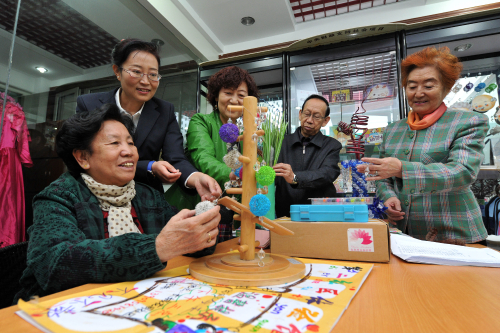|
 |
|
GROUP LIVING: Senior residents make handicrafts in a community care center in Yinchuan, Ningxia Hui Autonomous Region, on October 28. In Yinchuan, such centers offer new opportunities to elderly people during life after retirement by organizing various leisure activities. The facilities also help relieve pressure on family members who work away from home and don't have enough time to care for senior family members (PENG ZHAOZHI) |
Protection Funds
The Ministry of Finance (MOF) has allocated 8.84 billion yuan ($1.45 billion) in special funds to support the protection of cultural heritage this year.
The state funding to cultural heritage protection was 14.35 percent higher than a year ago, according to the MOF on October 28.
About 92 percent of the total funding, or 8.13 billion yuan ($1.33 billion), went to 2,299 cultural heritage protection projects, including the Great Wall, the Great Canal and the Silk Road.
Another 663 million yuan ($108 million) of funding supported efforts to protect non-tangible heritage items.
Joint Aid
China and Japan set up a foundation on October 28 to aid Chinese victims of chemical weapons left behind by Japanese troops during World War II.
Wang Jianlin, Deputy Secretary General of the China Foundation for Human Rights Development, and Minami Norio, a Japanese lawyer, signed the document for setting up the peace foundation in Harbin, capital city of northeast China's Heilongjiang Province.
Japan has a foundation for aiding the victims and will cooperate with the equivalent Chinese foundation to provide help to victims hurt by chemical weapons, said Norio, one of more than 30 Japanese lawyers who have been helping Chinese victims sue the Japanese Government.
Official Chinese statistics show Japan abandoned at least 2 million tons of chemical weapons at about 40 sites in 15 Chinese provinces at the end of World War II, most of them in the three northeastern provinces of Heilongjiang, Jilin and Liaoning.
More than 2,000 Chinese have been directly hurt by Japan's abandoned chemical weapons.
Antarctic Plane
Official sources have confirmed China's plan to deploy its first fixed-wing aircraft for Antarctic research in 2015.
China purchased a Basler BT-67 from the United States, an aircraft used by other countries on the continent. It is capable of flying in temperatures of minus 50 degrees Celsius on transportation, rescue and research missions, said Qu Tanzhou, head of the Chinese Arctic and Antarctic Administration.
The country's 31st scientific expedition to Antarctica, which set off on October 30, will choose a site for an airfield about 40 or 50 km from China's Zhongshan Station in eastern Antarctica, Qu said.
He added that it was also possible that China could share a Russian airfield near the station.
China has also planned to build an aviation network in eastern Antarctica to support field research, transportation and emergency response. | 